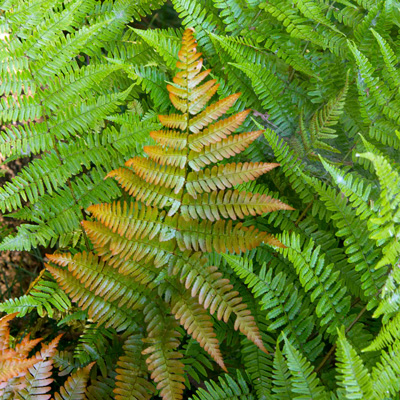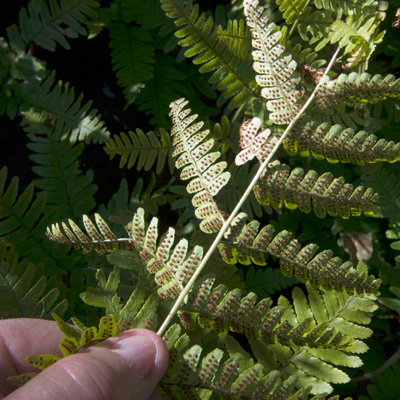Fabulous Ferns for Fall
Back in the ‘70s, if you were looking for a fern you really pretty much meant a wood fern – a longtime southern native fern that is handsome all summer, then dies to the ground for four or five months every winter.
Wood ferns are still out there performing their magic, and holly ferns are popular, too. They’re evergreen, and their individual leaflets are big and broad enough to look like some type of holly bush.

Photo: ‘Brilliance’ autumn fern has done famously in this mostly shaded spot in the Sperry home landscape.
But another group of small ferns is coming up in the pack. They’re grand, and they’re easy. Autumn ferns. Dryopteris erythrosora. It was a novelty fern you’d find in better nurseries and by mail order way back then. Now it’s much more mainstream, and we’re all coming out winners because of it.
I planted a bed of the variety ‘Brilliance’ about 18 months ago. We took some large pots of coleus out after they froze last week in our Collin County (McKinney) landscape, and the little ferns were behind them just thriving after spending a summer almost unnoticed.
‘Brilliance’ is a selection of the older autumn fern that I’ve grown for years. I’ve always liked the standard type, but when I saw this improved form at the Dallas Arboretum two or three years ago I decided immediately that it needed a place in our plantings.

Photo: Autumn fern ‘Brilliance’ develops a bronze tone as it toughens up for winter.
Autumn ferns’ needs…
• Shade (or minimal early morning sun);
• Highly organic planting soil;
• Moist soils at all times – perfect drainage, but never dry.
Autumn ferns’ niceties…
• Grows to 1 ft. tall and 15 in. wide;
• Deep green fronds;
• New growth may take on bronzy cast, especially just before winter;
• Rarely, if ever, crops up with insects or diseases.
Local independent retail garden centers usually have autumn ferns in the spring, and many will still have them now. You can also find several improved selections online simply by searching key words “Buy Dryopteris erythrosora”

Spores by the thousands!
Don’t be surprised to find rows of reproductive spores on the backs of the fern leaflets. Some folks mistake these for insects or insect eggs, and it’s a sad day when they start spraying to control them. Worse yet, in frustration, some people even cut all their ferns’ leaves off completely. Leave ‘em alone. Your plants are healthy and happy!
